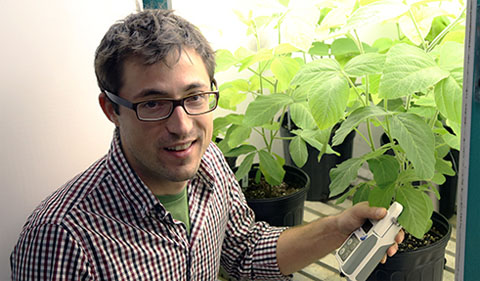
Nicholas Tomeok monitors the health of soybean plants, his research subjects for several studies, as they grow in environmentally controlled chambers.
The Environmental & Plant Biology Colloquium Series presents Nicholas Tomeo on “There is potential for natural genetic variation in photosynthetic physiology for improving crop photosynthesis” on Friday, Feb. 24, at 11:50 a.m. in Porter Hall 104.
Tomeo is a Ph.D. Candidate in the lab of Dr. David Rosenthal in the Environmental & Plant Biology Department at Ohio University.
Abstract: The world’s population is growing both numerically and in prosperity, necessitating continual growth in agricultural production. Photosynthetic efficiency is a critical determinant of crop yield potentials, though it remains little improved in modern crop varieties. Many strategies offer potential to enhance photosynthetic efficiency, though a common theme among them is a reliance on synthetic biology. Natural genetic variation is largely separate from this discussion despite its potential to provide the trait variation for selection in traditional breeding programs, and for informing which multivariate trait combinations are possible. One trait in particular where surveying natural genetic variation should prove profitable is the rate of carbon dioxide diffusion from substomatal cavities to the sites of carboxylation in chloroplasts, i.e., the mesophyll conductance. Several lines of evidence suggest photosynthetic rates and leaf water use efficiency are responsive to mesophyll conductance. Still, several practical questions remain before mesophyll conductance ought to be targeted for selection. To select a trait with standard breeding practices, 1) there must be heritable genetic variation for the trait, and 2) the trait must not have already been improved, i.e. the values of the trait in currently grown crop varieties must be lower than what is available in the wider pool of heritable genetic variation. With a focus on testing these two primary requirements, I assess mesophyll conductance in soybean and the model plant Arabidopsis thaliana. There was ample genetic variation for mesophyll conductance in both species exhibiting modest broad-sense heritability among genotypes. When the survey of diversity sampled was narrowed to only include a panel of US soybean cultivars released over the twentieth century, no variation in mesophyll conductance was observed indicating room for improvement. Photosynthesis was phenotypically and genetically correlated with mesophyll conductance, demonstrating both the influence of diffusional carbon dioxide supply on photosynthesis and a shared genetic architecture for these two traits. Despite conventional wisdom, the relationship between leaf water use efficiency and mesophyll conductance was inconsistent, and especially in soybean, selection for mesophyll conductance is unlikely to improve water use efficiency. I will further explore how the broader range natural genetic variation in photosynthetic physiology evaluated along with mesophyll conductance informs the ongoing discussion of improving photosynthetic efficiency.



















Comments